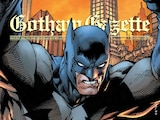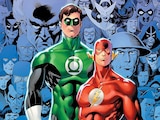You can only tease comic book fans for so long.
For the first five issues of THE MAN OF STEEL, the six-part miniseries kicking off Brian Michael Bendis’ run on both SUPERMAN and ACTION COMICS, we’ve been fretting and freaking out over the fate of Lois Lane and young Jon Kent, who have been MIA since the start of the series. Fortunately, Bendis and artist Jason Fabok have given us hints about what had happened to them—but up until last week’s issue #5, they were little more than teases.
Well, rest easy, Superman fans. With this week’s MAN OF STEEL #6, you’ll at last discover exactly what happened to Clark’s family and how he’s been taking it. You’ll also learn how—or if—Superman finally gets the better of Rogol Zaar, who is lighting the fires that have been wreaking havoc across Metropolis and even what happened to Superman’s old suit (you know, the one without the trunks).
Of course, you know the thing about answers—they only lead to more questions. They certainly did for us, so we thought it would be a good time to sit down with Brian to ask about the Last Son of Krypton as we find him in the last issue of Man of Steel. We got the writer to shed some spoiler-free light on what it was like working with six different artists on one project, why he took his time letting us know what happened to Lois and Jon, and whether he knew Fabok’s art was going to make us all cry. (He totally did!)
Plus, as a bonus, read to the bottom for a sneak peek at issue #6.

Brian, over your career you’ve worked with many amazing artists, but it’s rare that you work with six of them on one project like this. How was it writing for so many different artists all at once, and what did you think of the results?
The results are one of the great gifts of my life. I can tell you that right away. I looked at John Byrne’s original THE MAN OF STEEL series, and it was very much the John Byrne show—as it should have been. But I looked at what I wanted to bring to it and the differences in my take and what we were doing, and I thought that we should bring on a bunch of artists and really make a statement about how beautiful Superman is.
It was also a chance to hire some of the best who have ever done it that I had never worked with before, and that got really exciting. Of the six artists, I’d only worked with Kevin before. I’d never worked with any of the others. So, not only was it exciting, it was scary and dangerous because as anyone who’s ever done this can tell you, collaborations can be very intimate, exciting and explosive. Things can blow up, or they can be the best thing that’s ever happened to you. You don’t know what’s going to happen. In this situation, what I didn’t see coming was that the artists themselves would start an email chain and inspire each other on just a pure, artistic level to do the best work of their lives. Adam and Kevin had already told me, “What I’d like to do is the best Superman comic I could ever do. I haven’t done that and I want to do it before I die.”
When you have two of the artists already going in saying that they want to make this the best thing they’ve ever done, and then the other artists hear about it and I see them talking amongst themselves about it, all I can do is smile because not only do I know that I’m about to benefit a great deal, but all the readers are going to benefit because all the artists are inspiring each other to do their greatest work. We all win!
That was what happened. You’re seeing the final product—and now it’s not just me hyping, people have seen it—and you’re looking at some of the best work by some of the best artists that have ever drawn the character.

Looking back at Man of Steel as a debut project, why did you decide to start your run on Superman with a weekly miniseries rather than just starting with Superman and Action Comics?
It’s funny the way our culture is. What it feels like to hit the ground running feels different now than it used to. A lot of our culture is consumed so quickly. We knew there was a lot of Superman story we wanted to get to right away, so I wanted to hit the ground with six, seven, really eight weeks of weekly comics to say, “This is what we’re going to do with Superman.”
It also allowed me to be able to do the slow-burn mystery of what happened to Lois and Jon. That’s the kind of thing you could really only do in a graphic novel or a weekly. If I were to spread that out over six months of one-page-per-issue progression, people would have been murdering me. But I knew that in this form, it’s very enticing. It’s very exciting.
It was Dan DiDio’s initial idea. He suggested we think about the Man of Steel miniseries as a template and that if I had a story that fit into that, we should do it. Well, I did and I knew it immediately. It was the story you’ve just read. In the process, all the pieces started coming together on how Action and Superman were . It came together really smoothly, which made you feel like the story was being told the right way. Sometimes when you’re struggling, it’s because something’s wrong, there’s a piece missing. But when all the pieces come together like a beautiful Tetris, then you know something good is happening.
Jason Fabok was the only line artist to contribute to all six issues. Why parse out the flashback segments the way you did? Was it always the plan to have the same artist draw each one?
Yeah, it was pre-planned. I was a little frustrated that so many reviewers seemed to think he was filling in. I thought by the third issue, it was clear that it was on purpose—he was definitely drawing this section of the book. It was never fill-in, but it was designed in a way to ease some of the deadline pressure on guys like Adam and Kevin. So, it worked out well on many levels, but it was a pre-planned idea knowing that Jay was doing the sixth issue that it would all pan out in, so that when it did, it would all resolve in this style. It was like every issue of Man of Steel was giving us a preview of issue #6.
Also, I wanted to emphasize how this was haunting him. Something is haunting Superman, and that’s not a normal thing. What’s interesting when you do something like this, where we only show you some of the information, you get the fan reaction. It’s like a Rorschach test where they tell you what they see. I love that, and I knew that’s what would happen here. People would say, “Oh, Lois is dead! That’s it!”
But no one ever says when it’s over, “Oh, you didn’t kill Lois. I’m sorry for yelling at you.” No one ever does that.

Issue #6, even more than the other chapters, balances moments of heavy action with much quieter, more emotional character beats. How do you balance those without it seeming jarring?
It’s a lot more puzzle-work than people think. Sometimes the scenes kind of beg for each other. They come together kind of quickly. Other times, it’s a matter of massaging it. You really look at the scenes and try to find the truth in each one. As a younger creator, I didn’t realize that that’s what I was looking for in the scenes—I just knew I was looking for something. But now I realize I was always looking for whether the truth of the scene was being told and was it being told in the right place and at the right time.
When you’re cutting back and forth like this, there’s this juxtaposition of the kinetic energy and passion of the fight with the villain versus the more staid passion of watching Superman’s son’s heart break. Also, may I say, having not worked with Fabok before, I wrote it very convinced that he could pull this off, that the power of the fights and the intimacy of the emotion would be equally valid. He did an amazing, wonderful job.
There are some heartbreaking images in issue #6, and the emotion that he communicates through his art is just masterful. You can feel everything that’s happening in that one moment.
I’ve had luck in the past at Marvel—Mark Bagley being the most famous—and maybe it’s because I’m an artist as well, but I’m able to look in the eyes of some of the characters, even during the action scenes, and can tell that this artist has the ability to emote through the characters. So, when I see that, I always try to take a chance to see if this is something the artist not only can do, but wants to do and never gets the opportunity. I haven’t talked to Jay about this, but I just had to think that he would like to perform through the character, and he did. It was quite wonderful.
Man of Steel #6 is thirty pages of Jay Fabok artwork. It is almost a double-sized issue for the original price. We are not charging extra. I went over my page count, and Dan DiDio said, “Ah, let’s just give it to them for free for supporting the book.”
That’s all he ever said about it. There wasn’t a press release or anything about the extra pages, so I feel it’s incumbent upon me to tell everybody, “Hey, this book’s double-sized, and Dan just went with it!” It’s cool and part of what I love about comics, and I just wanted to share that. It feels big and it gave us the moment for the intimacy that we needed, so I was very grateful. Dan rewarded my unprofessionalism once again.
THE MAN OF STEEL #6 by Brian Michael Bendis, Jason Fabok and Alex Sinclair is available tomorrow in print and as a digital download.















